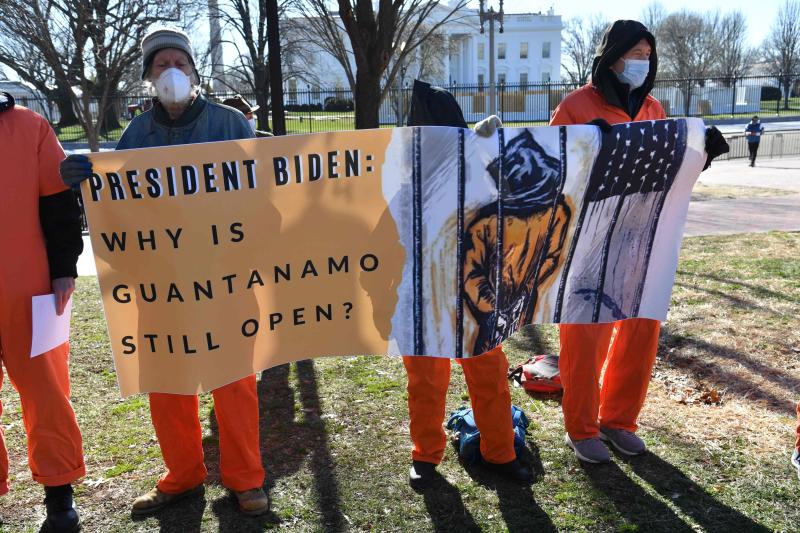Guantánamo prisoner ‘was waterboarded’; agents omitted it from memo
PUBLISHED : 29 JUL 2022 AT 09:35
WRITER: NEW YORK TIMES
0
0
Demonstrators hold a sign during a protest calling for the closure of Guantanamo in front of the White House in Washington DC on Jan 11, 2022. (Photo: AFP)
Demonstrators hold a sign during a protest calling for the closure of Guantanamo in front of the White House in Washington DC on Jan 11, 2022. (Photo: AFP)
GUANTÁNAMO BAY, Cuba: A prisoner accused of plotting al-Qaida’s bombing of the USS Cole warship in 2000 told federal interrogators years later that he was waterboarded by the CIA, an interpreter testified Thursday. But that detail was omitted from the official account of the interrogations that prosecutors want to use at his death-penalty trial as evidence that he confessed.
At issue in the hearings is whether the military judge will accept a 34-page memorandum written by agents who questioned the prisoner, Abd al-Rahim al-Nashiri, at Guantánamo Bay for three days in early 2007. The account of the interrogation is considered critical trial evidence. Defence lawyers say it is tainted by torture and want it excluded.
“He talked about the waterboarding,” said John Elkaliouby, who worked for the Federal Bureau of Investigation (FBI) as an Arabic linguist from 1994 to 2015. “He said, ‘I was waterboarded by the CIA,’ and I reported that to the whole team.”
Elkaliouby was called as a prosecution witness to describe the mood and atmosphere during the interrogation, which he said was friendly, calm and “at the pleasure of Mr Nashiri,” who was shackled at the ankles. The agents served tea and pastry, and the prisoner offered that he had been tortured.
Golden Globes group approve bid to take Hollywood award show private
Spielberg heads starry Toronto festival line-up
Gaysorn celebrated as luxury watch destination
The linguist cast the revelation as a surprise: “I didn’t expect that, to be honest.”
Testimony this week expanded on accounts that have emerged in the Sept 11 case of how military prosecutors built death-penalty cases against men who were tortured during secret detention in overseas prisons run by the Central Intelligence Agency (CIA), and then transferred to Guantánamo Bay in 2006 for trial by order of then United States President George W Bush.
The CIA had a secret role at Guantánamo in the detention and interrogations of the men by FBI and Navy law enforcement agents, including collecting the notes from interrogations, Elkaliouby said. The CIA required that the interrogators write their accounts of what they learned on agency computers, which were classified.
Before the interrogations started in early 2007, the federal agents were instructed to omit allegations of torture and abuse from what was colloquially called “clean team memos” — and instead write a separate account.
Defence lawyers have said they received copies of those separate accounts among classified documents prosecutors turned over to them in this pretrial phase. But it is impossible to know how the defendants raised the accusations because there are no recordings or transcripts of those interrogations.
Seventeen US sailors were killed in the suicide attack on the USS Cole during a refuelling stop in Aden, Yemen, on Oct 12, 2000. Although Nashiri was captured two years later and turned over to US custody, he was not charged until 2011. The case has been mired in pretrial hearings for more than a decade as defence lawyers have struggled to obtain and use information about his torture to disqualify evidence.
They also have argued that Nashiri, who is now 57 and has been diagnosed by US military doctors as suffering post-traumatic stress disorder, emerged from CIA detention in a state of “learned helplessness,” essentially trained to tell his US captors what he believed they wanted to hear.
Related: Cables detail CIA waterboarding at its secret Thailand prison
He was waterboarded in Thailand in 2002 by psychologists who worked as CIA contractors and was subjected to rectal abuse and threatened with a power drill and a gun during interrogations conducted by CIA agents. For a time in late 2003 and early 2004, he was hidden at Guantánamo Bay in a CIA black site near the prison facilities but out of reach of lawyers and the International Red Cross.
Detainees are brought meals of rice, beans, carrots, oranges at Camp X-Ray, at Naval Base Guantanamo Bay in Cuba on Jan 17, 2002, the first week the camp held detainees. (Photo: New York Times)
That site is known as Camp Echo 2, and it was where Nashiri was held in 2004 and then in 2007 for the interrogations that prosecutors consider central to their case.
Earlier Thursday, Bernard DeLury Jr, a retired Navy Reserve captain who is now a superior court judge in New Jersey, testified for prosecutors that on March 14, 2007, Nashiri was “alert,” “present” and not under distress during a hearing to review his status as an enemy combatant.
DeLury presided at the two-hour Combatant Status Review Tribunal, or CSRT, during which, he said, he had “no doubt in my mind” that the prisoner’s participation was knowing and voluntary.
The process prohibited prisoners from having a lawyer, but Nashiri was assigned a Navy officer to act as a “personal representative,” speak on his behalf and help him respond to the allegations that the military said were sufficient to detain him as, essentially, a prisoner of the war against terrorism.
A defence lawyer, Capt Brian Mizer of the Navy, asked DeLury whether he knew that Nashiri had told his representative, who was called Lieutenant Commander X in court, that he was “afraid that he would be executed and dismembered at his CSRT.”
DeLury replied: “If he had told me that, I certainly would have explored that with him.”
This article originally appeared in The New York Times.






























